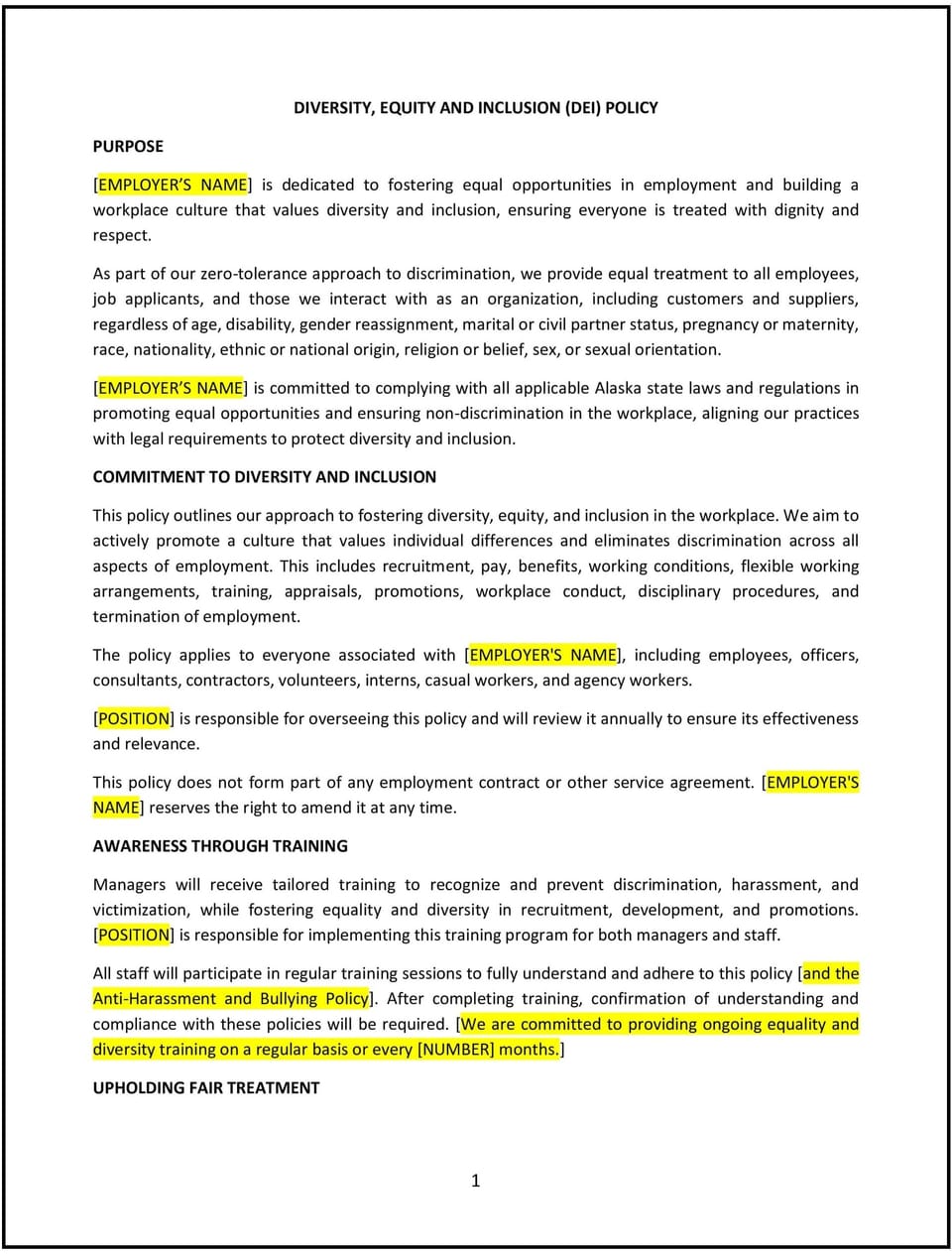Diversity, equity and inclusion (DEI) policy (Alaska): Free template

Diversity, equity, and inclusion (DEI) policy (Alaska)
In Alaska, a diversity, equity, and inclusion (DEI) policy establishes a commitment to fostering a workplace that values diverse perspectives, promotes equity, and ensures inclusivity for all employees. This policy helps businesses create an environment where everyone feels respected, valued, and empowered to contribute their best work. By implementing a DEI policy, businesses can enhance employee satisfaction, drive innovation, and align with societal expectations for workplace equity.
Given Alaska's unique cultural landscape, including indigenous communities and remote workforce dynamics, businesses can tailor their DEI policies to address regional challenges and opportunities for inclusivity.
How to use this diversity, equity, and inclusion (DEI) policy (Alaska)
- Define DEI principles: Clearly articulate the company’s commitment to diversity, equity, and inclusion, outlining its vision and goals.
- Set actionable objectives: Provide specific, measurable objectives to promote DEI, such as increasing diversity in hiring, offering training, or creating mentorship programs.
- Outline responsibilities: Assign roles for DEI initiatives, ensuring that leadership, HR, and employees understand their responsibilities in promoting inclusivity.
- Include reporting mechanisms: Establish procedures for employees to report concerns or provide feedback on DEI-related issues, ensuring their voices are heard.
- Communicate the policy: Share the DEI policy with employees during onboarding and regularly reinforce its importance through training and company-wide initiatives.
Benefits of using a DEI policy (Alaska)
A DEI policy provides numerous benefits for businesses in Alaska. Here’s how it helps:
- Encourages inclusivity: Creates a welcoming environment where all employees feel respected and valued, improving workplace morale.
- Drives innovation: Brings diverse perspectives and ideas to the table, enhancing creativity and problem-solving within the organization.
- Attracts top talent: Positions the company as an employer of choice for candidates seeking inclusive workplaces.
- Supports compliance: Helps businesses adhere to equal employment opportunity (EEO) laws and other relevant regulations, reducing risks of discrimination claims.
- Enhances reputation: Demonstrates a commitment to social responsibility and fairness, strengthening relationships with clients, employees, and the community.
Tips for using a DEI policy (Alaska)
- Tailor to local context: Address Alaska-specific DEI considerations, such as supporting indigenous communities and remote or seasonal workers.
- Provide regular training: Educate employees and leadership on unconscious bias, cultural competence, and inclusivity to promote a deeper understanding of DEI principles.
- Set measurable goals: Establish benchmarks for diversity hiring, leadership representation, and employee engagement to track the policy’s impact.
- Celebrate cultural diversity: Recognize and celebrate the diverse backgrounds of employees through events, communication, and workplace initiatives.
- Update regularly: Review the policy periodically to reflect changes in workforce dynamics, regulations, or best practices.
Q: What is the purpose of a DEI policy?
A: A DEI policy promotes a workplace culture that values diversity, ensures equitable opportunities, and fosters inclusivity, benefiting employees and the organization.
Q: How can businesses measure the success of their DEI initiatives?
A: Businesses can track metrics such as diversity in hiring, employee retention rates, participation in DEI programs, and feedback from employee surveys.
Q: What actions can businesses take to promote inclusivity?
A: Businesses can provide DEI training, create employee resource groups, celebrate cultural events, and implement mentorship programs to foster inclusivity.
Q: How does this policy address unconscious bias?
A: The policy may include training and tools to help employees and leadership recognize and mitigate unconscious bias in decision-making.
Q: How often should the DEI policy be reviewed?
A: The policy should be reviewed annually or as needed to ensure it aligns with evolving workforce needs, best practices, and regulatory changes.
This article contains general legal information and does not contain legal advice. Cobrief is not a law firm or a substitute for an attorney or law firm. The law is complex and changes often. For legal advice, please ask a lawyer.


